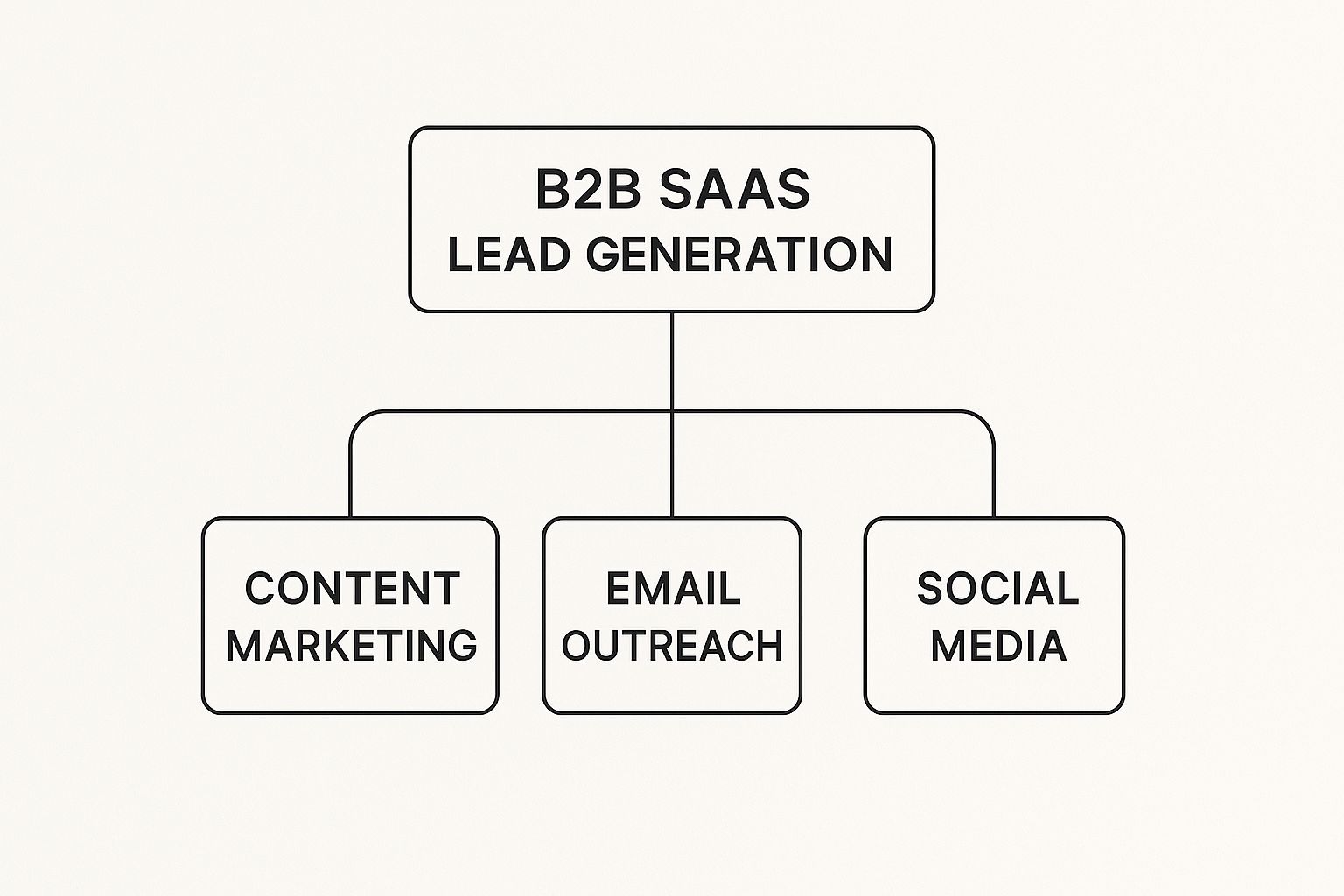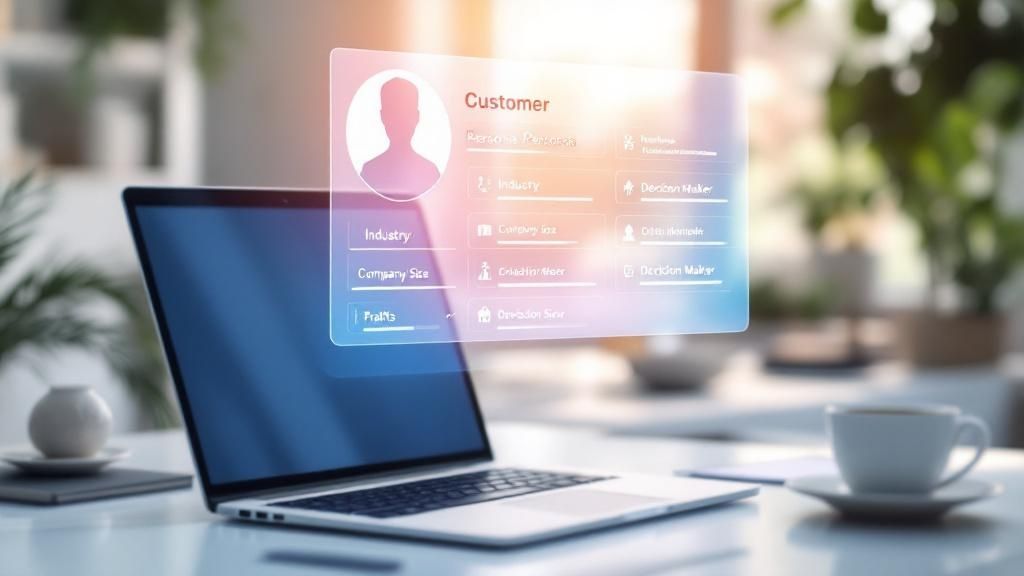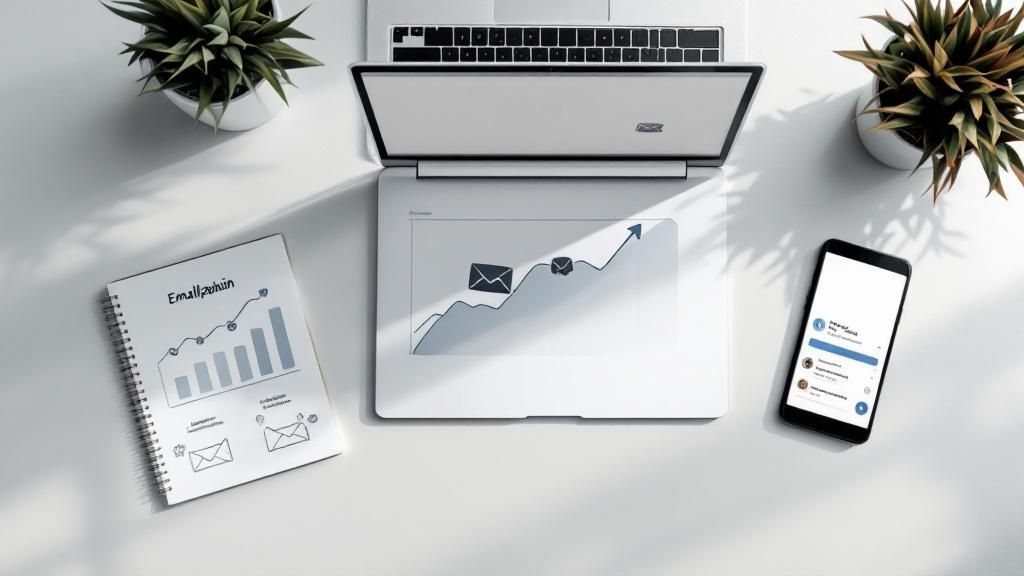At its core, B2B SaaS lead generation is the entire process of finding and attracting potential business customers for your software. It’s a blend of smart marketing and targeted sales work, all aimed at building a pipeline of qualified prospects who are actually likely to become paying subscribers. Get this right, and you have the foundation for real, sustainable growth.
Why Lead Generation Is Your SaaS Growth Engine
In the cutthroat world of B2B SaaS, just having a great product isn't enough to win. It's a hard truth. Think of your company like a high-performance car. Your software might be a finely tuned engine, but without any fuel, that car isn't going anywhere.
B2B SaaS lead generation is that high-octane fuel. It's the system that constantly tops up your tank, powering everything else you do—from closing deals to informing your next product update.
And this isn't just about grabbing a list of email addresses. It’s about creating a predictable, repeatable process that pulls in the right kind of businesses, keeps them interested, and ultimately turns them into happy, loyal customers. The stakes couldn't be higher, with the market projected to rocket past $900 billion by 2030. It's no surprise that 91% of B2B marketers now call lead generation their number one priority, pouring up to 50% of their budgets into it. If you want to dive deeper, you can explore more data on these B2B SaaS trends to see the full landscape.
To truly understand how this works in practice, let's look at a few core concepts that every modern B2B SaaS team should know. These pillars form the bedrock of a solid lead generation strategy.
Core Pillars of Modern B2B SaaS Lead Generation
| Pillar | Description | Key Objective |
|---|---|---|
| Inbound Marketing | Creating valuable content (blogs, webinars, guides) that naturally attracts prospects who are actively searching for solutions. | Pull in potential customers by being helpful and authoritative, not disruptive. |
| Outbound Prospecting | Proactively reaching out to specific, well-researched accounts and contacts through channels like email, social media, or calls. | Initiate conversations with ideal-fit companies that may not be aware of your solution yet. |
| Lead Nurturing | Building relationships with leads over time by providing relevant information and support, guiding them through their buying journey. | Keep your brand top-of-mind and build trust until a prospect is ready to buy. |
| Sales Qualification | Systematically vetting leads to determine if they have the need, budget, and authority to become a customer. | Focus sales resources on the prospects most likely to convert, increasing efficiency. |
These elements don't work in isolation; they feed into each other to create a cohesive system for growth. One powerful way to visualize this interconnectedness is through the SaaS Growth Flywheel.
The SaaS Growth Flywheel
A much better way to think about this whole process is the SaaS Growth Flywheel. Forget the old-school funnel where customers just fall out the bottom. A flywheel uses the momentum from your happy customers to spin faster and attract new ones.
Here’s how it works:
- Attract: You draw people in with genuinely useful content and smart solutions, not by shouting at them with interruptive ads. This is where your inbound marketing really gets to work.
- Engage: You start building real relationships. This means offering personalized value and showing exactly how your software solves their unique problems.
- Delight: You go above and beyond to provide a stellar customer experience. This turns your users into your biggest fans—advocates who then refer new business, which adds more energy and spins the flywheel even faster.
High-quality leads are the first big push that gets this flywheel moving. Every new qualified lead adds a little more force, accelerating your company's growth over time.
The infographic below breaks down the core channels that provide this initial push.

As you can see, things like content marketing, email, and social media are the foundational channels for attracting and engaging potential customers. Getting these right is absolutely essential for building a powerful lead generation machine that fuels sustainable, long-term growth for your SaaS.
Navigating the Modern B2B SaaS Sales Journey

The old sales funnel—you know the one: TOFU, MOFU, BOFU—was a decent starting point. But let's be honest, it’s getting a little long in the tooth. Today’s B2B buyers don't follow a neat, straight line. Their path looks more like a twisting country road, full of detours for research, U-turns to consult with colleagues, and multiple stops along the way.
Instead of trying to force people down a rigid funnel, think of effective B2B SaaS lead generation as being a trusted guide on that journey. Your role is to anticipate what your prospect needs around the next bend and hand them the right map—your content—to get them closer to their destination. This isn't about pushing leads through a pipeline; it's about building relationships and proving your value, step by step.
This journey is almost always longer and more tangled than a typical B2C sale. You're dealing with multiple decision-makers, endless research, and a healthy dose of risk aversion. That means your content strategy has to be patient, genuinely helpful, and laser-focused on earning trust over time.
The Awareness Stage: Where Problems Come to Light
Right at the beginning, your future customers aren't searching for your product. They probably don't even know it exists. They just know they have a problem to solve or a goal to hit. Their Google searches are broad and exploratory, things like "how to improve team productivity" or "best ways to track project milestones."
Your goal here isn't to sell. It's to educate. You have to show up where they are with high-value, problem-centric content that plants a flag and says, "We know this territory."
- Educational Blog Posts: Go deep on the questions they're asking, without ever mentioning your software.
- Informative Infographics: Make complex data easy to digest and share.
- Original Research Reports: Publish unique data that positions your company as a thought leader.
This is where you'll find Information Qualified Leads (IQLs). These are folks who have dipped a toe in the water by reading your content but aren't anywhere near ready for a sales call.
The Consideration Stage: Where Solutions Are Weighed
Once a prospect has a name for their problem, they shift into research mode. Now, they're actively comparing different approaches, methods, and, yes, vendors. They've gone from asking "what's my problem?" to "what are the best ways to fix this?"
Here, your content needs to pivot from general advice to specific solutions, gently introducing your product as a top contender. You need to show them how their problems can be solved.
- Case Studies and Testimonials: Nothing builds confidence like seeing that you've helped a company just like theirs. Social proof is king.
- Webinars and Live Events: Host deep-dives that showcase your expertise and let prospects see your product in action while asking questions.
- Detailed Whitepapers or Ebooks: Offer comprehensive guides that compare different types of solutions and position your methodology as the smartest choice.
"Just because someone signed up for a webinar or downloaded an ebook doesn’t mean they want to be sold to… But this is the perfect opportunity for email to shine by providing relevant, interesting, and engaging content… Position yourself as a trusted partner—before you sell to them." – Jaina Mistry, Director of Brand and Content Marketing at Litmus
At this point, leads who engage more deeply—by attending that webinar or downloading a case study—graduate to become Marketing Qualified Leads (MQLs). They fit your ideal customer profile and have shown real interest, making them ripe for more focused nurturing from your marketing team. To dive deeper into this, our guide to B2B sales lead generation has more on the process.
The Decision Stage: Where Choices Are Made
Finally, the prospect has a shortlist. They're ready to make a call. They have the budget, the buy-in, and a clear understanding of what they need. Your job now is to remove any last-minute friction and make saying "yes" to you the easiest decision they'll make all week. Your content should be direct, transparent, and all about your product.
At this critical moment, leads who take a big step like requesting a demo or starting a free trial are upgraded to Sales Qualified Leads (SQLs). These are your hottest leads, and they need to be handed off to your sales team for a prompt, personal follow-up. Don't leave them waiting.
Building Your Inbound Lead Generation Machine

A powerful inbound strategy isn't about hunting for leads. It's more like building an intricate, self-powering machine. Rather than chasing down prospects, you design a system that naturally attracts, engages, and qualifies them on its own. It becomes the engine that works for you 24/7, pulling in potential customers who are already searching for solutions.
This machine is assembled from several interconnected parts. Each piece has a specific job, but they all work in concert to generate a steady stream of high-quality prospects. The core components are high-value content, search engine optimization (SEO), and engaging virtual events. When you put them together correctly, this system becomes the very foundation of successful B2B SaaS lead generation.
Crafting High-Value Content as Your Magnet
Content is the fuel that powers your inbound machine. This isn't about just churning out blog posts to hit a quota; it's about creating genuinely useful resources that solve your Ideal Customer Profile's (ICP) most urgent problems. Think of every piece of content as a magnet, specifically calibrated to attract a certain kind of lead.
Content marketing is absolutely essential here. In fact, a staggering 85% of B2B marketers now rely on content to generate leads, which tells you everything you need to know about its importance in building trust. For instance, 77% of marketers report podcasts are effective for raising awareness, with blog posts right behind at 76%. This focus on value-packed content shows just how powerful it is for engaging prospects early in their journey.
Your content arsenal should be diverse, built to meet people at different stages of their buying process:
- Blog Posts & Articles: These are your front-line soldiers. You optimize them for SEO to answer the exact questions your ideal customers are typing into Google. They’re perfect for building authority and drawing in that initial wave of traffic.
- Whitepapers & Ebooks: This is your premium, gated content that works as a powerful lead magnet. By offering a deep dive into a complex subject, you provide massive value in exchange for a prospect's contact details.
- Case Studies: These are your proof points. They don't just tell, they show how your SaaS solution has delivered tangible results for businesses just like your prospect's.
By creating this kind of helpful content, you start building a relationship long before a salesperson ever enters the picture. You position yourself as a trusted advisor, not just another vendor. To see how these pieces fit into the bigger picture, it helps to understand how they guide prospects through a modern inbound sales funnel.
Making Your Content Discoverable with SEO
Creating brilliant content is only half the job. If nobody can find it, it can't do its work. This is where search engine optimization (SEO) comes in—it’s the critical wiring that connects your content machine to the wider world. SEO is what makes sure your valuable resources pop up right when and where your prospects are looking.
SEO is the art and science of making sure that when someone searches for a solution to a problem your SaaS solves, your content is the first thing they see. It’s about being the most relevant answer.
Think of it like this: a prospect with a problem is like someone lost in a forest. Your content is the map that shows them the way out. SEO is the big, flashing signpost that points them directly to your map instead of a competitor’s. This involves researching the keywords your audience actually uses, optimizing your site, and building authority so that search engines see you as a credible source.
Engaging Prospects with Webinars and Events
While written content is fantastic for education, webinars and virtual events add a powerful human touch to your inbound machine. They create a space for direct, real-time engagement, helping you build a community and generate high-intent leads at scale.
A webinar is so much more than a simple presentation; it's an interactive experience. It lets you:
- Demonstrate Value: Show your product in action, walking through features as they solve a real-world problem.
- Establish Expertise: Position your team as thought leaders by hosting discussions on industry trends and best practices.
- Capture Qualified Leads: The people who take the time to register for and attend a webinar are signaling a much higher level of interest than someone who just skims a blog post.
Every blog post, ebook, and webinar needs to lead somewhere—usually to a landing page where the magic of lead capture happens. To get the most out of your inbound traffic, mastering landing page design best practices is a non-negotiable. A well-designed page can dramatically boost the number of leads your machine produces from the exact same amount of traffic. When you combine all these elements, you create a powerful, self-sustaining engine that fuels your company’s growth.
Executing Personalized Outbound Lead Generation
While inbound marketing works like a magnet, pulling prospects toward you, outbound is all about proactively going out and finding them. It’s about reaching those high-value, perfect-fit companies that might not even know you exist yet.
The old image of outbound is just… ugly. We all think of pushy, spammy, impersonal messages blasted out to thousands of people. But effective, modern outbound for B2B SaaS is the complete opposite. It’s surgical. It's value-driven. And it's deeply personal.
The secret to successful outbound isn't a numbers game. It's about the quality of each touchpoint. This means you have to do your homework and have a legitimate, well-researched reason to connect. The goal here isn’t to demand a demo on the first try; it’s simply to start a conversation.
This mindset shift is critical. It shows you respect a prospect's time and intelligence, positioning you as a helpful expert, not just another salesperson clogging their inbox.
Mastering Strategic Cold Outreach
A great cold email has one job: to be more valuable than the time it takes to read and delete it. That's it. This means you can't just copy and paste a generic template to hundreds of people. Each message has to be a hyper-relevant note built on genuine research into the prospect's company, their role, and what they've been up to.
Honestly, the best cold emails aren't really "cold" at all. They’re warmed up with personalization.
- Mention a recent trigger event: Did their company just land a new round of funding, hire a C-suite executive, or get a shoutout in the news? Mentioning this proves you’re paying attention.
- Acknowledge their work: Did you read a blog post they wrote, hear them on a podcast, or see a project they led? This shows you're interested in them as a professional, not just as a lead.
- Zero in on a specific, relevant pain point: Based on their industry and title, what's a challenge they're likely facing? Briefly hint at how you solve it, but resist the urge to launch into a full sales pitch.
The real objective of a cold email isn't to book a meeting. It's to start a conversation. Offer a helpful resource, ask a thought-provoking question, or share a unique insight. Once you have a real dialogue going, the opportunity for a meeting will come up naturally.
Targeted Prospecting on LinkedIn
If you use it right, LinkedIn is the ultimate playground for B2B outbound prospecting. It's a treasure trove of professional data, but its real power is in the ability to engage before you ever send a connection request. Blasting generic InMails is a surefire way to get ignored.
Instead, a smarter approach involves a few key steps:
- Identify Key Decision-Makers: Use Sales Navigator to find the exact people who fit your Ideal Customer Profile at your target companies.
- Engage Before Connecting: Don't just hit "connect" right away. For a week or two, follow them. Like their posts. Leave thoughtful, genuine comments on their content. This gets you on their radar in a completely non-threatening way.
- Send a Personalized Request: When you finally do connect, reference your recent engagement. Something as simple as, "Hi [Name], I really enjoyed your recent post on [Topic]. Would love to connect and follow your work," is infinitely more effective than the generic default.
- Add Value After Connecting: Once they accept, don't immediately pitch! Continue the conversation by sharing a relevant article or resource you think they'd find useful.
The Power of Account-Based Marketing
Account-Based Marketing (ABM) is the pinnacle of personalized outbound. It completely flips the traditional funnel on its head. Instead of casting a wide net to catch leads and then qualifying them, you start by identifying a shortlist of high-value "dream" accounts and treat each one as a market of its own.
With an ABM strategy, your sales and marketing teams work together to create a hyper-personalized campaign aimed at key people within a single company. This might involve customized content, highly targeted ads, personal emails, and even direct mail—all designed to speak directly to that company's unique goals and challenges.
Sure, ABM requires more upfront effort. But the payoff can be huge, often leading to larger deal sizes and much stronger customer relationships. Many of these tactics are covered in our guide to effective lead generation strategies and tips, which can easily complement an ABM framework.
Measuring What Matters in Your Lead Funnel

If you can’t measure something, you can’t improve it. It’s a classic business saying for a reason. While it feels great to see a jump in website traffic or a spike in social media followers, these are often just "vanity metrics." They look impressive on a report but don’t actually tell you if your B2B SaaS lead generation strategy is making you money.
To build a real growth engine, you have to cut through that noise. The key is to zero in on the key performance indicators (KPIs) that directly show the health of your business. This means tracking the numbers that reveal how efficiently you’re turning your marketing budget into paying customers.
Think of your marketing spend like an investment portfolio. You wouldn't just throw money at random stocks without checking their performance, right? The same logic applies here. Every dollar you spend on generating leads has to be accountable.
The Core Metrics That Drive Decisions
To get a truly clear picture of your lead funnel's performance, you need to dig deeper than surface-level data. A handful of core metrics will give you a real understanding of your return on investment and how well your sales and marketing machine is running.
These numbers work together to tell a story, from what it costs to get a lead in the door to the total value that customer brings to your business over their entire time with you.
-
Cost Per Lead (CPL): This is as straightforward as it gets. It tells you exactly how much you spend, on average, to generate one new lead. Just divide your total marketing campaign cost by the total number of new leads you got from it.
-
Lead-to-Customer Conversion Rate: This KPI shows you how good you are at turning interested people into actual paying customers. To find it, divide the number of new customers by the total number of leads, then multiply by 100 to get a percentage.
-
Customer Acquisition Cost (CAC): This takes CPL a step further by calculating the total cost to get a customer, not just a lead. It bundles all your sales and marketing expenses over a certain period and divides it by the number of new customers you signed in that same timeframe.
-
Customer Lifetime Value (LTV): For SaaS, this is the holy grail metric. LTV is the total revenue you can reasonably expect to make from a single customer account over the entire course of their relationship with your company.
The most critical relationship in SaaS economics is the balance between LTV and CAC. A healthy business model absolutely requires that the value of a customer is significantly higher than the cost to acquire them. A common benchmark to aim for is an LTV to CAC ratio of 3:1 or higher.
The Investment Analogy: LTV and CAC
Let's break that down with a simple analogy. Think of your Customer Acquisition Cost (CAC) as your initial investment. It’s the money you put down to get a customer to sign up. Your Customer Lifetime Value (LTV) is the total return you get on that investment over time.
If your CAC is $1,000 but your LTV is only $800, you’re losing money on every single customer you bring in. That’s a recipe for disaster. But if your CAC is $1,000 and your LTV is $5,000, you’ve built a profitable, scalable business. This one ratio tells you if your growth is sustainable or if you're just burning cash.
Understanding Attribution Models
To accurately figure out metrics like CPL and CAC, you have to know which marketing channels are actually bringing you the leads. This is where attribution models come in. They are basically the set of rules you use to give credit for a conversion to the different touchpoints in a customer's journey.
Here’s a quick look at the most common models:
| Attribution Model | How It Works | Best For |
|---|---|---|
| First-Touch | Gives 100% of the credit to the very first channel the lead ever interacted with. | Understanding which channels are best at creating initial awareness and filling the top of your funnel. |
| Last-Touch | Gives 100% of the credit to the final channel the lead interacted with right before converting. | Identifying which channels are most effective at pushing people over the finish line to close deals. |
| Multi-Touch | Spreads the credit across multiple touchpoints along the buyer's journey. | Getting a complete, balanced picture of how all your marketing efforts work together to create a customer. |
Choosing the right model really depends on your business goals. For social media, where engagement can happen over a long and winding path, it’s crucial to connect your efforts to financial results. A key piece of this puzzle is knowing how to measure social media ROI, making sure your time and money translate into tangible returns.
By tracking these core metrics and understanding where your leads truly come from, you create a powerful feedback loop. This data-first approach lets you stop guessing, double down on what works, and constantly fine-tune your lead generation strategy for the biggest possible impact.
Don't get caught up chasing the latest "secret hack" for B2B SaaS lead generation. Real, lasting success doesn't come from a single tactic or a short-term sprint. It comes from building a powerful, unified system designed to run for the long haul—an engine that consistently drives your company forward.
This growth engine rests on three core pillars. First, you have to get obsessed with your customer's actual journey. Forget the old, rigid funnels. The goal is to guide them by delivering the right value at exactly the right time, whether they're just realizing they have a problem or are weighing their final options. This shifts your marketing from a bunch of disconnected activities into one seamless, supportive experience.
Blending and Optimizing for Growth
Next, you have to masterfully blend inbound attraction with personalized outbound prospecting. Think of them as two sides of the same coin. Inbound strategies like great content and SEO act as a powerful magnet, pulling prospects toward you. At the same time, targeted outbound lets you proactively start conversations with your most high-value accounts. When they work together, your pipeline stays full.
Finally, the whole machine needs to be fueled by a relentless commitment to data-driven optimization.
The ultimate goal is to create a self-sustaining feedback loop. You deploy your strategies, measure what actually moves the needle—like LTV and CAC—analyze the results, and then pour those insights right back into the engine to make it stronger and more efficient.
This is the real blueprint for sustainable growth. It’s about building a connected system where understanding the buyer, blending channels, and constant optimization all work in perfect harmony. With this approach, you're not just fueling this quarter's revenue; you're building a B2B SaaS lead generation engine that will secure your company's growth for years to come.
Frequently Asked Questions
Diving into B2B SaaS lead generation always stirs up a few questions, whether you're mapping out a high-level strategy or getting into the weeds of daily tactics. Let's tackle some of the most common ones that pop up for sales and marketing teams.
What Is the Difference Between a Lead and a Prospect?
It's really easy to mix these two up, but they're not the same. They actually represent two very different points in the sales journey.
Think of it this way: a lead is anyone who waves at your boat. They've shown a flicker of interest—maybe they downloaded an ebook or signed up for your newsletter. They're on the radar, but that's about it.
A prospect, on the other hand, is the exact fish you came to catch. They've been qualified, they perfectly match your ideal customer profile (ICP), and they have a real problem that your software can solve. They're not just near the boat; they're nibbling on the bait. Every prospect starts as a lead, but only a fraction of leads will ever become true prospects.
How Long Does It Take to See Results?
This is the big one, and the only honest answer is: it depends. The B2B SaaS sales cycle is famously long, often stretching out over several months. The timeline really comes down to the strategies you're using.
- Outbound Strategies: If you're running targeted cold email campaigns or an Account-Based Marketing (ABM) push, you can see initial replies and book meetings within a few weeks. But getting from that first conversation to a signed contract is still a marathon.
- Inbound Strategies: This is the long game. Things like content marketing and SEO are powerful but require patience. You might not see a meaningful bump in organic traffic for 6-12 months. The payoff? The leads that come through are usually much higher quality and create a sustainable flow of business down the road.
The key here is patience. Focus on building real relationships and consistently delivering value, and the results will eventually stack up.
If there's one mistake I see companies make over and over, it's expecting B2B SaaS lead generation to deliver overnight success. The goal isn't to find a short-term hack; it's to build a sustainable engine. The best performers blend quick-win tactics with long-game strategies for a healthy, balanced pipeline.
Which Lead Generation Channel Is Best?
There's no magic bullet here. The "best" channel is really a mix of channels that works for your specific product, audience, and budget. In almost every case, a multi-channel strategy is the way to go because it makes your lead flow more resilient.
For most B2B SaaS companies, a winning combination often includes:
- Content Marketing & SEO: This is your foundation. It builds your brand's authority and pulls in prospects who are actively searching for answers you can provide. It's the engine for long-term, organic growth.
- LinkedIn Prospecting: In the B2B universe, nothing beats LinkedIn for zeroing in on and starting conversations with decision-makers at your dream accounts.
- Personalized Email Outreach: When it's done well—and not just another spammy mass blast—targeted email is still one of the most direct and effective ways to connect with high-value prospects.
My advice? Don't try to be everywhere at once. You'll just spread your resources too thin. Start by picking two or three channels where you know your ideal customers hang out. Get really good at them, track your results obsessively, and then expand based on what the data tells you. It’s better to do a few things exceptionally well.
Ready to build a powerful, automated sales outreach machine? Salesloop.io provides the tools you need to identify prospects, create personalized campaigns, and fill your pipeline with qualified leads—all with less manual effort. Start your journey to scalable growth today. Learn more about Salesloop.io.





